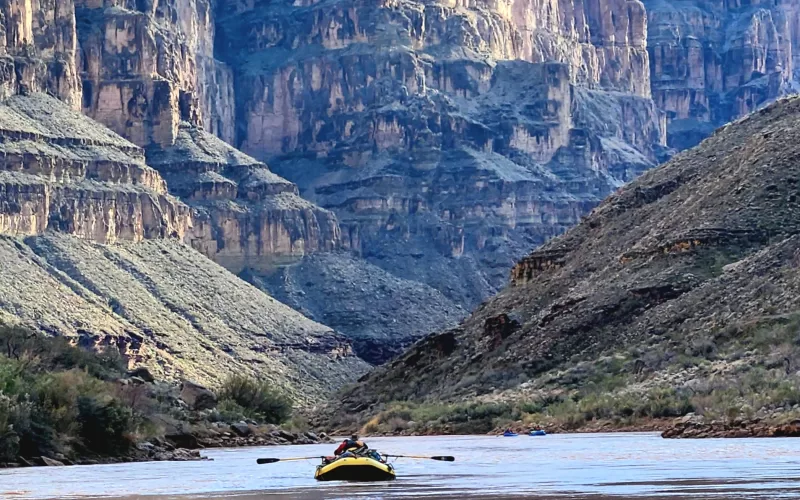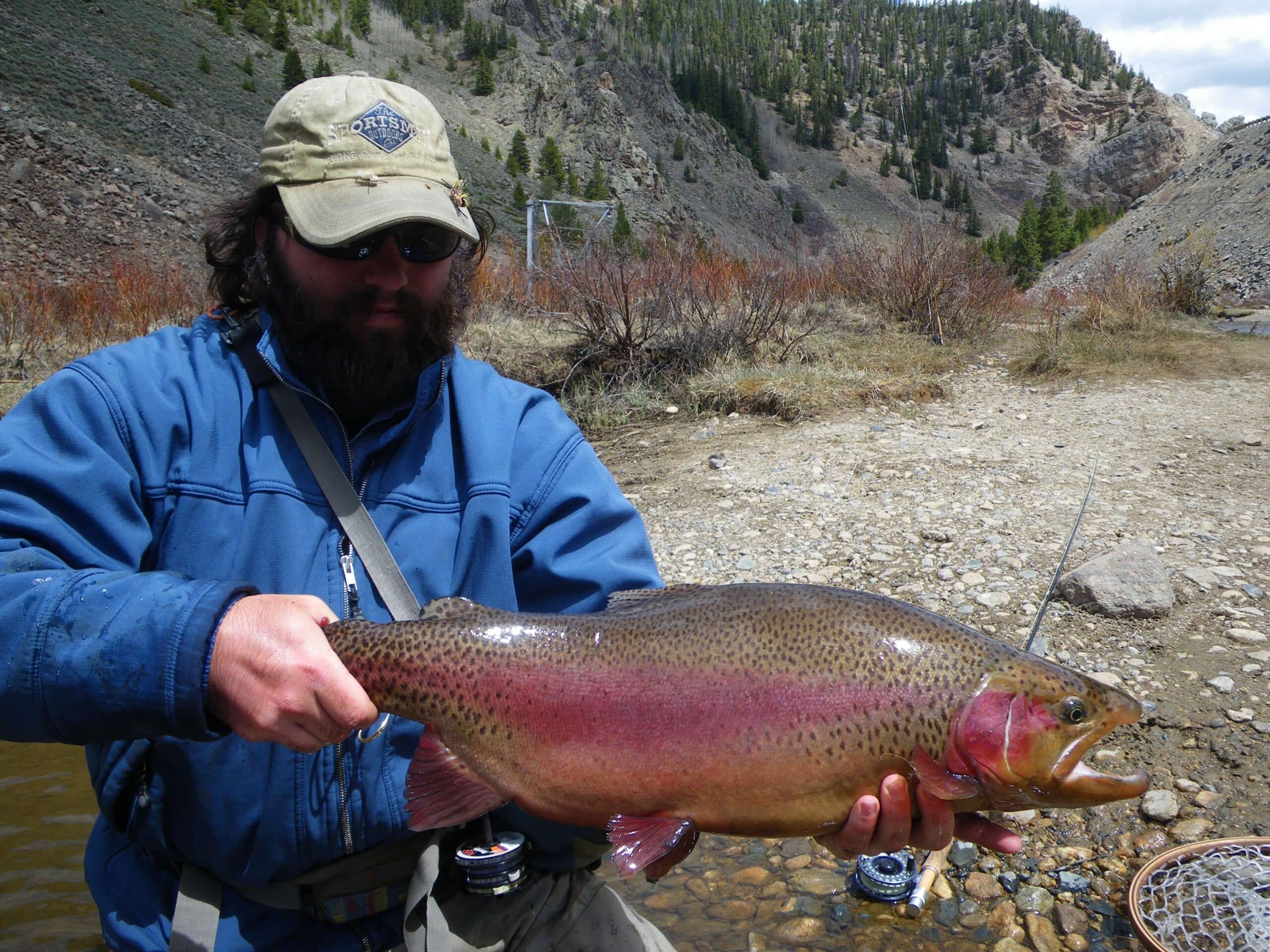Did you draw a permit for a Grand Canyon Rafting trip? The river is among the most coveted in the world and you must either draw a permit or book a commercial trip. Every day of the year is managed under a strict system and there are no shoulder seasons or self issue permits. Ideally, you can run the entire month long trip and get the full experience but shorter private and commercial trips also create great access opportunities.
Flows Below Glen Canyon Dam

Drawing a Grand Canyon Rafting Permit
The permitting process is a lottery system run through the National Park Service. The main lottery is open to applicants in February and is drawn at the end of the month. You can complete the application process online. After the primary results are announced, many recipients will defer or cancel trips.
The logistics and timing make it difficult and some permits are returned to the pool for a follow-up lottery. These follow up lotteries take place as needed to reassign permits. Keep yourself engaged with the park service because these second chance drawings can have better odds.
If you don’t draw, that leaves two options: take a commercial trip or find a permit holder looking for extra hands.
Planning Your DIY Trip
So you drew a permit to raft the Grand Canyon. Now what? It’s a long trip and not one where you can just wing it. Planning, organizing and hashing out the details with your group is important leading into this expedition
Self Supplied vs Outfitted Trips
If you already have a 16-18 foot raft rigged for big water expeditions, running your own game makes sense (smaller rafts are also possible). You will still need camp gear, a waste system, dry bags and safety gear. If you have the raft however, it’s likely you have some of this gear as well.
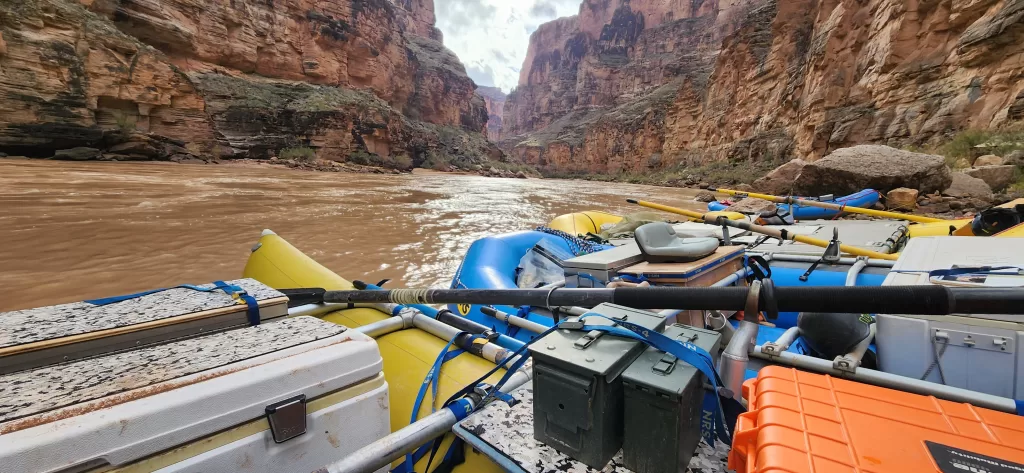
Planning out meals is the tricky part. A mix of dehydrated meals and easy prep, wholesome meals works well. You want to save space where possible but also want to enjoy filling dinners that replace all of the calories burned rowing through the heat each day. Plan out every single meal and bring plenty of snacks and extras to ensure your rations last.
Outfitted trips are a popular option and for good reason. Several companies have built gear and food systems that save rafters an incredible amount of time and energy. The crazy thing about these outfitted rigs is the cost effectiveness (especially when divided by multiple passengers). If you prepare all of your own meals, the cost is pretty much a wash when compared to the outfitted rigs. They will rent rafts and a do a full door to door service. Essentially, you show up with dry bags loaded with your camp gear and personal items and they have your raft, food, kitchen setup, groovers, first aid kits and meals ready to roll. They drop off the rig, run shuttles and pick you up at the takeout.
We used Moenkopi Riverworks in Flagstaff for logistics/shuttles and a rental boat, groover, water filtration, etc. (we did our own food and personal gear). They were fantastic and are all river runners who work super hard to make everything come together.
Ceiba Adventures and Canyon R.E.O. are also great options for outfitting. Grab a quote for everything or go a la carte to fill the gaps in your program. I will say that the groover rental from Moenkopi is worth every penny. They handle the clean out after the trip and you simply return the system.
Group Selection for Grand Canyon Rafting Trips
The trip leader (TL) is the permit holder and ultimately the decision maker for groups. The maximum group size is 16 people. Keep in mind that more people means more planning. We had seven total on my last trip and it was a very nice, manageable number of folks.
When selecting a group, it’s always nice to choose people you know and trust. Understanding their skill levels and willingness to do chores and share the load is important. That said, plenty of groups come together as strangers.
How Much Booze to Bring Along
This might be the greatest debate for canyon runners. Many trips begin with a very heavy load that is lightened daily as beer cans are drained and crushed. It really depends on your group but the long term planning aspect is a bit tricky.
Beer is bulky and it’s better to bring along some hard liquor that you drink sparingly. The younger crowds often pack a ton of alcohol but 30-days of partying is a bit much so plan on rest days and limit consumption to the evenings when you aren’t focused on running rapids.
Trip Dynamics and Conflict on the River
On the day before your launch, you will unload gear at the ramp (there’s a camp just below the staging area) and a ranger will check the permit, individual photo ID’s and all mandatory NPS equipment. They check PFD’s, first aid kits, safety gear, etc. Following the checks (or on launch day), the ranger will do an orientation and explain the rules, regulations, rescue procedures and all other important information.
After your group is cleared, you can launch and head down the river. It’s a good idea to keep a waterproof guidebook close for campsites and rapid descriptions. Having a passenger engaged will keep you on track. Using a GPS helps as well but you can get by just fine with a guidebook only.
Other groups will be on the river and many have different permit days. This means you will overlap and have some competition for campsites. It’s a good idea to communicate with other groups as you go to coordinate timelines and work together when possible. Otherwise, it’s first come – first serve for campsites and you may not always get your desired locations. Luckily, pretty much every camp is wonderful.
Conflict can occur between groups and it’s best to simply run your own program and be private and respectful if another group is causing issues. If they are breaking the regulations, trashing campsites or anything along these lines, wait until the trip is over and alert the park service. These issues are rare but know that while you will have plenty of space on the river, other groups are present with an influx in the summer months.
My Rafting Gear List from a 25-day Winter Trip
Personal Clothing:
- 4x Wool Socks
- 3x light socks
- 6x underwear
- 2x shorts
- 4x t-shirts
- Alpacka poncho
- Rain Jacket
- NRS Drysuit and Kokatat river shoes
- Neoprene booties (never needed them)
- 3x long underwear, tops and bottoms
- 2x mid layer Fleece
- Simms puffy jacket
- Neoprene gloves
- Winter gloves
- Beanie
- Hiking shoes
- Crocs for camp
- Muckboots
Camp Gear
- 2-person MSR backpacking tent
- 0-degree sleeping bag
- Down blanket
- Pillow
- Hand warmers
- NRS river pad
Boat Gear
- 16′ RMR Cataraft with Downriver frame
- Dry box
- Igloo Cooler
- Downriver drop bag
- Downriver water bottle holder
- K-pump
- Throwable flotation cushion (NPS requirement for boats over 16′)
- 2x throw ropes
- Pulleys for pin kit
- First aid kit
- Repair kit with patches, extra valves, wrenches
- 2x spare oars (NPS requirement)
- PFD + spare pfd
- Whistle
- Helmet
- Lots of camp straps
- Dry bags for all personal gear and secret snack bag
- Bow line
Electronics and Personal Stuff
- Goal zero solar
- Goal zero battery
- Lucy light 2x
- Headlamp 2x + AAA batteries
- GoPro + 3x extra batteries – pre charged
- Cell phone with waterproof pouch
- Garmin in-reach mini
- 3x books
- Journal and pen
Toiletries
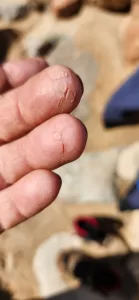
- Toothbrush + Paste
- Dr Bronner’s Soap + Rags
- Camp suds for laundry
- Dude wipes
- Sunscreen
- Lotion and Working Hands salve (your fingers and hands will need this)
- Nail clippers
Kitchen Setup
- Personal Thermos
- 2x folding tables
- 1x roll a table
- Downriver dish drying station
- Sand mat (NPS requirement)
- 2 burner stove
- 4x – 20lb propane tank (we consumed 1.5 tanks with 7 people in 25 days)
- Kitchen dry box with plates, utensils, pots and cast iron skillet
- Bucket for camp garbage with bags
- Ammo can with bleach, dish soap, kitchen strainer, scrub pads
- 3x collapsible kitchen buckets
- 2 bucket hand wash station (NPS requirement)
- Electric water filtration system (from Moenkopi)
- 4x – 5-gallon water jugs
- Backup manual filters
Waste Systems:
- 2 bucket hand wash station for groover site (NPS Requirement)
- Ammo can with groover toilet seat, cleaning supplies and toilet paper.
- 4x groover ammo cans with eco safe containers (just enough for 7 people on 25 day trip)
- Heavy duty contractor trash bags
- Garbage was secured in extra dry box and cooler space as it became available
General Group Gear:
- Fire pan and fire blanket (we carried extra coals to each campsite and packed out all ashes)
- NRS tarp
- Camp chairs
- Bocce ball, cards and other games
Additional National Park Service Requirements:
- Satellite phone
- Signal mirror
- 3′ x 8′ colored panels (for helicopter landing zones)
Commercial Rafting Trip Options
I’m all about the DIY but commercial outfitters do offer a great option for navigating the canyon. The river is big and running with the experts makes a big difference. It also means you can book a trip without drawing a permit.
Grand Canyon rafting day trips and 3 day rafting trips are options. Not everyone can commit to a month in the canyon so these shorter trips are really a great way to experience the river without quitting your job. Longer trips of several weeks and the full month are life changing experiences however.
Colorado River Rapids in the Grand Canyon
The rapids use a unique rating system on a scale of 1-10 and they are not always perfectly accurate as flows change rapid dynamics. In low water, a normal 4-5 rated rapid can become more difficult with exposed rocks and kicking waves. On the other end, a rapid like Hermit will have more flip potential at higher flows.
We are not including every rapid here. You can find detailed info for every riffle and minor rapid in the guidebooks. These are the more major and consequential rapids.
Mile 0 – Lees Ferry Launch
The launch site is generally slower in winter but can be super busy in summer. The upstream section is a paved ramp for motorized watercraft going upriver and the lower section is for raft trip staging.
Mile 0.2 – Paria Riffle
This is only significant because it’s the first bit of current speed you will encounter. The run is generally left, looking out for rocks. River right often has anglers fishing.
Mile 8.0 – Badger Creek Rapid – Level 5
Rated at a 5, this is the first real rapid you will hit. It’s pretty much a straight run down the left/center tongue and through some big waves. You can scout this from the rim ahead of the trip.
Mile 11.4 – Soap Creek Rapid – Level 5
Straightforward run down the center/right. Keep your eyes peeled for exposed boulders at lower flows.
Mile 14.5 – Sheer Wall Rapid – Level 2
Another straightforward read and run with a boulder down low to dodge. You’ll have plenty of time and visibility to see the boulder in most cases.
Mile 17.1 – House Rock Rapid – 7
Scout right or left on this one. We scouted left and it’s a nice view of the rapid. House rock forms a big hole about two-thirds of the way through the rapid and all of the current pulls left into the wall and subsequent hole. An aggressive downstream ferry, moving left to right, will get you to the right side for a clean line. If you end up too far left, hold on and work hard to miss the meat of the hole.
Mile 17.7 – Redneck Rapid – 3
Not a significant rapid and it’s a down the middle run. We did this at low water and the wave train has some funky waves to push through.
Mile 20.7 – North Canyon Rapid – Level 5
Read and run through a 12′ drop. This one is fun and pretty easy to read.
21.4 – 21 Mile Rapid – Level 5
Read and run that kicks off the roaring 20’s. These are a series of exciting rapids that come in close succession.
23.2 – 23 Mile Rapid – Level 5
Watch the lateral on river right on the entry here. Otherwise, it’s a nice drop down the tongue and a clean ride through the wave train.
23.5 – 23.5 Mile Rapid – Level 4
Another splashy run down and an easy read. Go left of the center pour-over on the entry.
24.4 – Georgie Rapid – Level 6
You have some confidence after the last set of fun rapids and up comes Georgie. This one has a quick drop with lateral breaking in both directions. The entry is everything and it has a bit of a horizon line as well. Some rowers push hard left to break over the lateral and others punch straight down the middle. I surfed this one by entering left without enough momentum to break over the lateral.
Mile 24.7 – 24.5 Mile Rapid – Level 6
Drop in the center and migrate left to stay off the right side where a few holes are present.
Mile 25.1 – 25 Mile Rapid – Level 6
Moving left through the rapid to avoid trouble on river right. Beware of the wall on river left lower in the rapid.
Mile 25.7 – Cave Springs Rapid – 5
Read and run with a 5′ drop and a rock to miss mid-tongue.
Mile 26.8 – Tiger Wash – Level 5
Line up on the waves and watch for breaking laterals then dodge the rocks after the wave train.
Mile 44.0 – President Harding Rapid – Level 4
Worth noting because of the large boulder and weird hydraulics. The common run is left of the boulder.
Mile 56.3 – Kwagunt Rapid – Level 5
Drop in left of the pour-over and move back to the right while squaring up on waves.
Mile 69.0 – Tanner Rapid – Level 6
A few technical moves are required to miss the rocks in this one. Enter left of the center pour-overs then scoot back to river right to avoid a shallow rocky section mid-rapid.
Mile 69.9 – Basalt Rapid – Level 6
The rapid is fairly simple but it has some power and consequences. Generally, stay right to miss the lift-side hole and manage your oars through the waves and hydraulics.
Mile 72.9 – Unkar Rapid – Level 6
Take advantage of the stop to explore the Unkar Delta hikes and scout this rapid at the same time. It has a few different options for runs and our group all ran slightly different lines. Entering and pulling right to miss the rocks on the left was a nice line, even in low water.
Mile 75.8 – Nevills Rapid – Level 6
This is a good, busy rapid that changes with the flows. At lower flows, keep a sharp eye for rocks and pour-overs. Some of this gets covered at high flows but can also form nice waves to hit.
Mile 77.1 – Hance Rapid – Level 8
Hance makes folks nervous and for good reason. It’s a long rapid with a tricky entry. Flip on the entry and you have a very long swim through a boulder strewn rapid. A down stream ferry that puts you behind the first set of left/center boulders will setup to continue pulling left to miss the big stuff. If you end up center or right, square up on the waves and doge the big boulders that make this rapid tricky.
Mile 79.1 – Sockdolager Rapid – Level 7
The right entry is tough but the left entry is clean. Line up on the waves and watch out for pour-overs throughout. This is a fun rapid.
Mile 82.1 – Grapevine Rapid – Level 7
This one is a blast. Enter left of the obvious rocks just right of center. There are holes on either side and some fun waves down the middle to ride past the danger. It has a nice drop and plenty of stuff to punch through.
Mile 84.1 – 83 Mile Rapid – 4
Push from the left to reach the middle for a smooth drop in, missing the left side pour over. Hit the waves head on and keep rightish for a smooth ride.
Mile 85.3 – Zoroaster Rapid – Level 5
Line up on the waves and stay sharp on the oars while pushing through hydraulics. The river pulls right into a wall but you have plenty of room to pull off and ride the current past the wall.
Mile 88.1 – Kaibab Bridge and Phantom Ranch
Not a rapid but a notable landmark for the boat beach Hike-in and hike-out exchange point. Keep your rafts upriver on the beach so motorized boats can use the deeper water for landings.
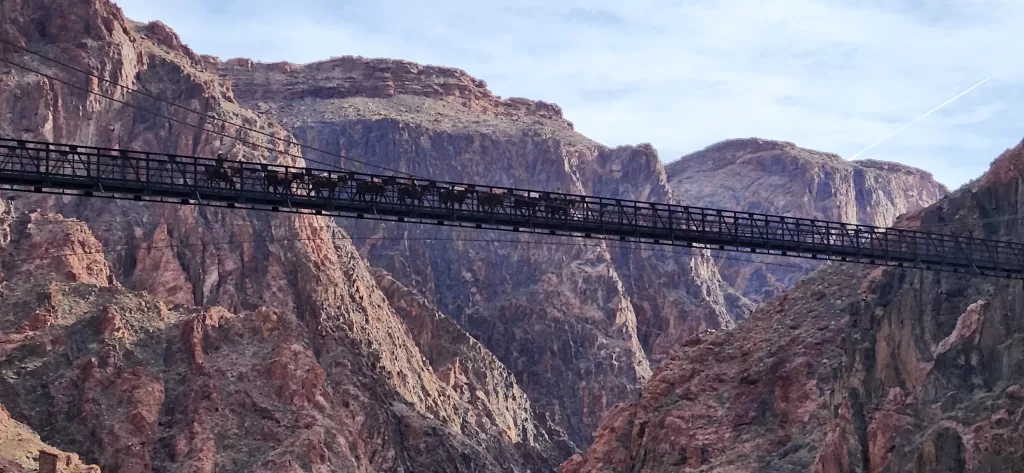
90.8 – Horn Creek Rapid – Level 8
This is a technical entry with big water and plenty of flip and pin potential. Personally, I think it’s one of the more difficult rapids in the canyon. The current pushes hard right, into a wall with pin potential. The right side also has some large boulders. The far left has large boulders as well. This means you want to run just left of center, pretty much below the horns.
You can enter on a right to left maneuver, pulling just behind the right horn. After crossing the horn, straighten out quickly and hit the waves below. The second option is better at higher flows (10,000 cfs+) and it involves a direct entry by splitting the horns. Hang on tight because it’s a big drop into big water.
Whatever you do here, get far enough left to avoid being pushed into that right wall. That’s where many boats find themselves in trouble, especially at lower flows.
Mile 93.9 – Granite Rapid – Level 8
Scout on river left and you can walk the length of this rapid for a great view. It’s fast and intimidating with the current pounding into the right wall and a big hole on the left leaving a tight space to squeeze through.
The entry is everything for this rapid, lining you up just off the right wall. Mind the strong laterals and square up on the big waves and it will carry you down the current line, past the hole on the left. It’s a fast, exciting run.
Mile 95.5 – Hermit Rapid – Level 8
If you love big waves, Hermit has plenty. They form midway and towards the end of the rapid but staying left or right helps boaters miss the biggest of the boat flippers. The waves lose some punch in lower water and gain strength at higher levels.
Mile 98.2 – Crystal Rapid – Level 8
Scout right and watch out for the notorious, boat flipping hole. You can do a tight to the bank right run or a left run on this rapid. We split boats and covered both lines here on the last trip. For the right run, pull back continuously, hugging the bank while avoiding the holes. Some boaters push into the left as well but I prefer pulling here. The right channel below Crystal has some boulders to watch out for in low water as well.
The left run has a big entry, a big boulder on river left and a nasty eddie just below the boulder. Don’t run too far left but give yourself some space to miss the center hole as well. The left channel is your best bet after running the main rapid.
Mile 99.7 – Tuna Creek Rapid – Level 6
Run down the right side, past a boulder in the middle, then pull left a bit in the lower waves.
Mile 101.8 – Sapphire Rapid – Level 6
Watch the big hole in the middle. Otherwise, this is a read and run, take it as it comes.
Mile 106.5 – Serpentine Rapid – Level 7
Enter left of the big pour-over and run the wave train on the right. It’s a fairly large rapid and a the waves are fun to hit.
Mile 112.8 – Walthenberg Rapid – Level 6
Either run the skinny right side and watch for rocks or hit the wave train on the left. There’s a hole in the middle that forces a right or left run. I’ve run left and it’s a nice line.
Mile 129.7 – Specter Rapid – Level 6
Mind the wave train on the right wall. Leave enough room to stay off the wall but beware of a hole left of the wave train.
Mile 131.1 – Bedrock Rapid – Level 7
This one can either be very smooth with a clean right run or very hectic with an unintentional left run. Downstream ferry left to right and cut across the current, into the soft water on the far right. If you miss this move, the river pulls hard left, into a massive boulder. If you get past the boulder, the left channel has a nasty eddie followed by strong pin and flip potential.
Mile 132.3 – Deubendorff Rapid – Level 7
Scout on river left. This rapid has a few possible routes and plenty of action. The lower left section has rocks and waves. If you end up here, get square and punch on through them.
Mile 150.2 – Upset Rapid – Level 8
Scout on river right just above the rapid. You can walk the right bank on this one for a good view but it still doesn’t show the left line well. If you run right, pull early and hard to get right of the big hole. It’s a long, sustained move that isn’t easy but is clean if made properly.
The left line looks chaotic but is a better option for many boaters and it’s fun in the big water. Enter on the left, pushing towards the wall then square up for the waves, staying just left of the big hole.
Mile 179.7 – Lava Falls Rapid – 10
Lava is big, fast and fun. t’s the last big one on the trip as well. The scout is on river right and while it shows the rapid well, you can’t see much on the entry. Using landmarks and features in teh current will help position for the entry.
For the right run, entering on a right to left push into the lateral just right of the ledge hole is a great setup to hit the next series of waves. Get square and dig deep for the big kahuna and you are through. If you end up too far right, there are some eddies and waves that are not friendly.
For the left run at high water, you can sneak left of the ledge hole and stay left, missing the big waves entirely. The entry remains difficult for this left run.
Mile 180.1 – Lower Lava Rapid – Level 4
Stay alert just after Lava Falls and pull off the wall a bit in this final drop before tequila beach.
Mile 225.9 – Diamond Creek Takeout
Take-out point for many trips. You can however extend to Pierce Ferry for a few more rapids and mellow float out.
What to Expect Each Month
January – Middle of winter with low temperatures and short days. Rafting the Grand Canyon during January doesn’t mean it’s always frigid however. Some nice sunny days still arrive and the scenery is quiet and beautiful.
February – Private trips will run and rafters are still wearing full dry suits. It’s quiet, cold but still beautiful. Running a winter trip requires excellent gear and preparation.
March – You can see a mix of spring and winter weather. The night temperatures are still pretty cold and the days are not long but you get much more light than the middle of winter. The occasional winter storm can still arrive. Commercial trips typically begin in the middle of this month.
April – Temperatures are comfortable with daily highs in the low 80’s. You still have cold nights and cold water so clothing and safety equipment remain important. This is a great month however because it’s not scorching hot or too cold.
May – The weather warms up and you are entering summer now. May is a wonderful month to raft with pleasant weather and plenty of sunshine. It’s a popular month for this reason.
June – The heat rises in June but many days are still very comfortable in the 80’s. Night time temperatures do remain cool however with the canyon walls and cool river present. Overall, June is pretty idyllic.
July – The peak tourism season has arrived but the river is permitted and traffic is never overwhelming. Commercial trips are running full swing however. Temperatures can get fairly hot but hey, you’re on a big river so take a swim. Summer storms can deliver cloud cover and rain as well.
August – Similar to July so leave the dry suits at home for Grand Canyon rafting trips. The heat can really turn up in August but it’s still an incredible river trip with nice, star filled nights.
September – The daily highs will start sliding backwards but the heat is still on for a good portion of this month. Cooler nights and fall flows mean the river is reliable and in great shape.
October – Fall rafting trips come with some very ideal weather. Beautiful warm days, comfortable nights, tons of stars and low crowds. October is a prime month and it also has a ton of demand on the permit applications.
November – The fall trend continues and this can be a perfect month. Some years, the entire month comes with prime weather and others, winter can set in early. You must prepare for everything and brings cold weather gear starting in November.
December – Short winter days and cold weather are not uncommon but it’s perfect when the sun creeps over the canyon walls.
Books About the Colorado River
Doing of the Thing – Buzz Holstrom was ahead of his time and the man lived an incredible life, chasing rivers, building boats and running expeditions just for the sake of doing it. This is a must read for anyone who loves whitewater.
Emerald Mile – The story about a couple of crazy bastards chasing the speed record is wild but this book is much more. It dives deep into the history, ecology and local characters that have shaped the Grand Canyon.
The Exploration of the Colorado River and It’s Canyons – John Wesley Powell and his crew set out to explore and map the great rivers of the southwestern United States. His journals and accounts of the river and his expedition into a remote wilderness with little knowledge about the place is a bedrock historical narrative akin to the Lewis and Clark Expedition.
If you drew a permit, enjoy the trip of a lifetime on this incredible river. If you didn’t draw and still want to go on a private trip, join the forums and Facebook groups where people are planning trips. Many trips need leaders, support boats and extra participants. If you’re schedule is flexible, getting on the grand is entirely possible.
